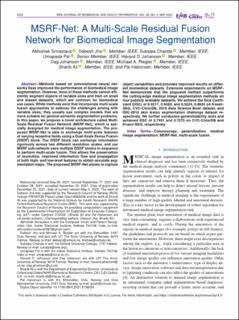| dc.contributor.author | Srivastava, Abhishek | |
| dc.contributor.author | Jha, Debesh | |
| dc.contributor.author | Chanda, Sukalpa | |
| dc.contributor.author | Pal, Umapada | |
| dc.contributor.author | Johansen, Håvard D. | |
| dc.contributor.author | Johansen, Dag | |
| dc.contributor.author | Riegler, Michael | |
| dc.contributor.author | Ali, Sharib | |
| dc.contributor.author | Halvorsen, Pål | |
| dc.date.accessioned | 2022-12-06T13:39:02Z | |
| dc.date.available | 2022-12-06T13:39:02Z | |
| dc.date.created | 2021-12-23T20:06:04Z | |
| dc.date.issued | 2021-12-23 | |
| dc.identifier.issn | 2168-2194 | |
| dc.identifier.issn | 2168-2208 | |
| dc.identifier.uri | https://hdl.handle.net/11250/3036164 | |
| dc.description.abstract | Methods based on convolutional neural networks have improved the performance of biomedical image segmentation. However, most of these methods cannot efficiently segment objects of variable sizes and train on small and biased datasets, which are common for biomedical use cases. While methods exist that incorporate multi-scale fusion approaches to address the challenges arising with variable sizes, they usually use complex models that are more suitable for general semantic segmentation problems. In this paper, we propose a novel architecture called MultiScale Residual Fusion Network (MSRF-Net), which is specially designed for medical image segmentation. The proposed MSRF-Net is able to exchange multi-scale features of varying receptive fields using a Dual-Scale Dense Fusion (DSDF) block. Our DSDF block can exchange information rigorously across two different resolution scales, and our MSRF sub-network uses multiple DSDF blocks in sequence to perform multi-scale fusion. This allows the preservation of resolution, improved information flow and propagation of both high- and low-level features to obtain accurate segmentation maps. The proposed MSRF-Net allows to capture object variabilities and provides improved results on different biomedical datasets. Extensive experiments on MSRF-Net demonstrate that the proposed method outperforms the cutting-edge medical image segmentation methods on four publicly available datasets. We achieve the Dice Coefficient (DSC) of 0.9217, 0.9420, and 0.9224, 0.8824 on Kvasir-SEG, CVC-ClinicDB, 2018 Data Science Bowl dataset, and ISIC-2018 skin lesion segmentation challenge dataset respectively. We further conducted generalizability tests and achieved DSC of 0.7921 and 0.7575 on CVCClinicDB and Kvasir-SEG, respectively. | en_US |
| dc.language.iso | eng | en_US |
| dc.publisher | Institute of Electrical and Electronics Engineers | en_US |
| dc.relation.ispartofseries | IEEE journal of biomedical and health informatics;Volume: 26, Issue: 5 | |
| dc.rights | Navngivelse 4.0 Internasjonal | * |
| dc.rights.uri | http://creativecommons.org/licenses/by/4.0/deed.no | * |
| dc.subject | Colonoscopy | en_US |
| dc.subject | Generalization | en_US |
| dc.subject | Medical image segmentation | en_US |
| dc.subject | MSRF-Net | en_US |
| dc.subject | Multi-scale fusion | en_US |
| dc.title | MSRF-Net: A Multi-Scale Residual Fusion Network for Biomedical Image Segmentation | en_US |
| dc.type | Peer reviewed | en_US |
| dc.type | Journal article | en_US |
| dc.description.version | publishedVersion | en_US |
| cristin.ispublished | true | |
| cristin.fulltext | original | |
| cristin.qualitycode | 1 | |
| dc.identifier.doi | https://doi.org/10.1109/JBHI.2021.3138024 | |
| dc.identifier.cristin | 1971848 | |
| dc.source.journal | IEEE journal of biomedical and health informatics | en_US |
| dc.source.volume | 26 | en_US |
| dc.source.issue | 5 | en_US |
| dc.source.pagenumber | 2252 - 2263 | en_US |

